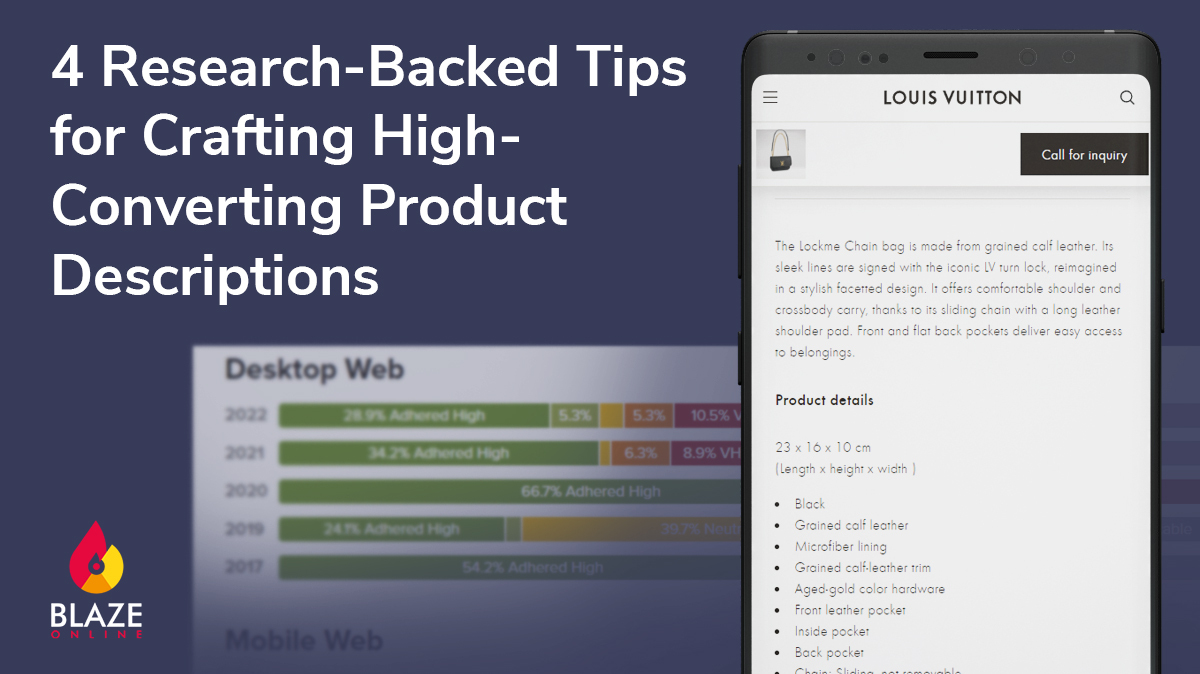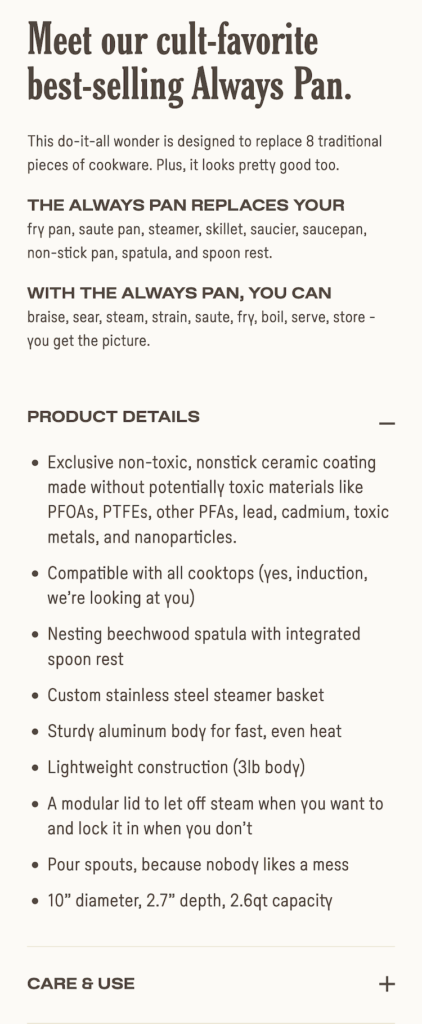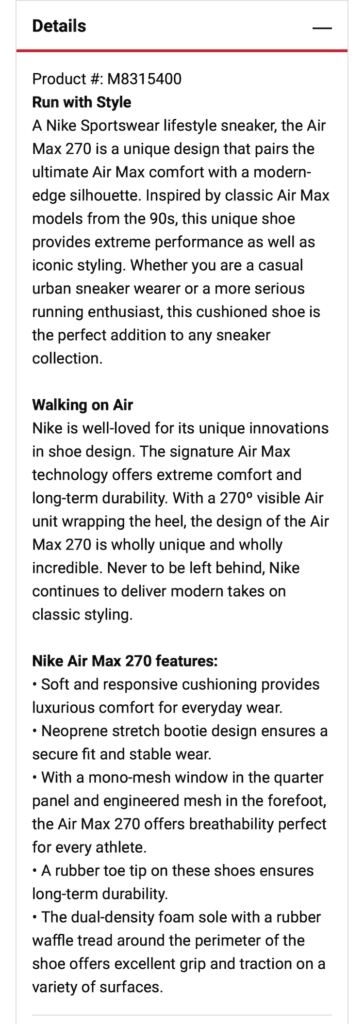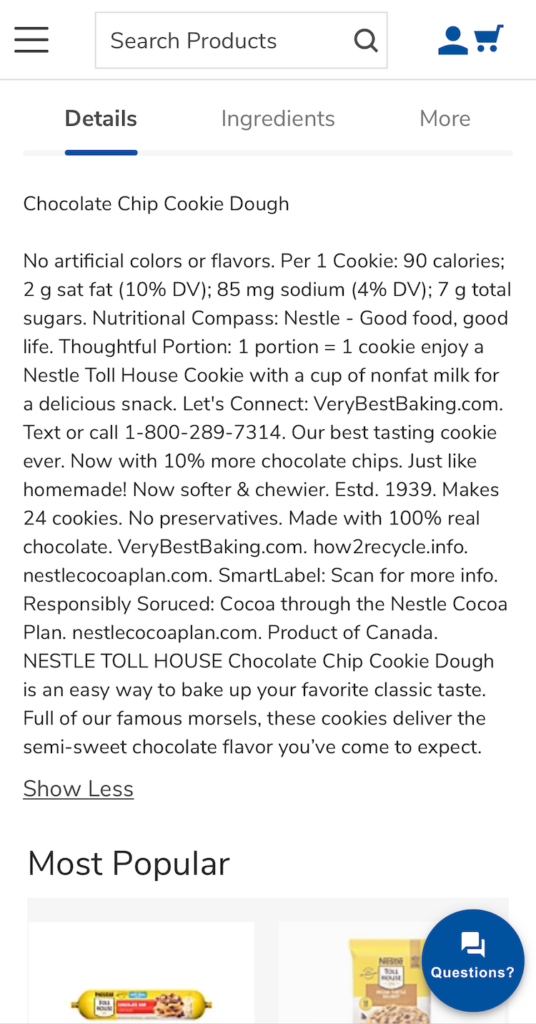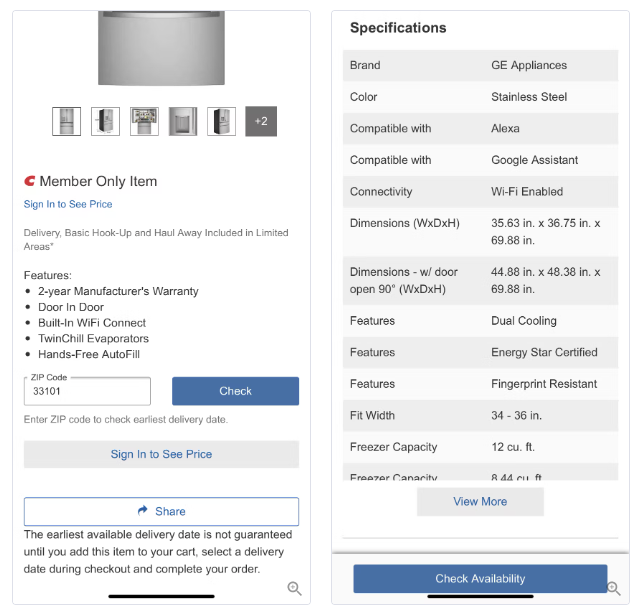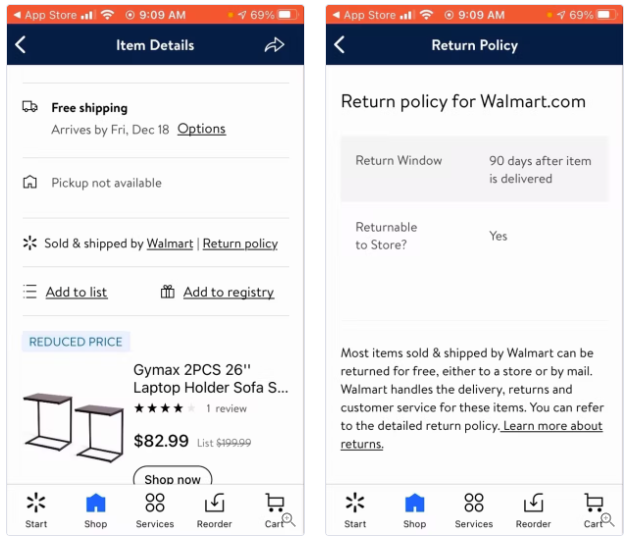What makes a great product description? When customers visit your online store and land on a product page, they’re trying to determine if it’s the right fit for them. The information in your product description plays a crucial role in their decision-making process.
But how do you know if you’re providing the information they need to add it to their cart?
Here are four tips, backed by research, to help you write compelling product descriptions that increase conversions:
- Use Both “Bullet Lists” and “Blocks of Text” for Product Descriptions
- Subdivide Long Product Descriptions with Sections and Headings
- Provide Core Product Info Both in the Product Description and in the Spec Sheet
- Display or Link to the Return Policy from the Main Product Page Content
Let’s dive in.
Use Both “Bullet Lists” and “Blocks of Text” for Product Descriptions
Did you know that different users have different ways of searching for product information?
Depending on their information-gathering style, where they are in their purchasing decision, and how familiar they are with the product, they might want to either scan the information quickly or read it all in detail.
There are three key implementation details to keep in mind for this design pattern to be fully effective:
- Ensure Visual Differentiation
- Duplicate Core Product Information
- Ensure Proximity of Bullet Lists and Text Blocks
During UX research, it was observed that if participants came across product descriptions made up of large blocks of text with few or no bullets, they often felt overwhelmed and had difficulty finding relevant information.
When participants encountered bullet lists with few or no blocks of text, they were often left with unanswered questions about technical terms or features. In either case, the product description was judged by users to be insufficient, and the product was often abandoned.
That’s why it’s important to ensure your product descriptions cater to both types of users. To do this, you should use a combination of text blocks and bullet lists.
The text blocks should give a comprehensive overview of the product, possible use cases, and a detailed explanation of the features.
The bullet lists, on the other hand, should keep things simple by just listing the key features and specs. And here’s the key – make sure the core information is present in both the text blocks and bullet lists. Use appropriate spacing in your bullet lists and place the bullet lists and accompanying text blocks close to each other.
This way, everyone will be able to find what they’re looking for, whether they’re scanning or reading.
Examples of Good Product Descriptions
Examples of Poor Product Descriptions
Subdivide Long Product Descriptions with Sections and Headings
The presentation of product descriptions is crucial in determining a customer’s purchasing decision.
Long, unbroken, and unstructured product descriptions can be intimidating and make it difficult for customers to locate the specific information they require. To combat this issue, it’s recommended to divide lengthy product descriptions into themed sub-sections using descriptive headings. This will make it easier for customers to scan and find the information they need quickly.
It’s important to note that these sub-sections should not be separated into different product pages. The subsection headings should be specific and written in a way that makes them easily readable for customers who are scanning the product description. The product descriptions should not only be easy to scan but also be detailed enough to cover all aspects of the product that may interest the customer.
During testing, it was found that participants had difficulties navigating unstructured product descriptions that lacked headings, and some even avoided reading the description altogether.
Customers who find it difficult to consume the content within product descriptions are more likely to overlook relevant information or skip the product description altogether. Scattering the product description across a product page makes it difficult for customers to find the information they need.
So, strive to create structured, readable, and comprehensive product descriptions that aid customers in making informed purchasing decisions.
For users to reap the full benefit of subsection headings, three common pitfalls must be avoided.
- Subsection Headings that Blend into the Surrounding Text or Bullets
- Scattering the Product Description throughout the Product Page
- Overly Broad or Vague Headings
Examples of Good Subdivide Long Product Descriptions
Examples of Poor Subdivide Long Product Descriptions
Provide Core Product Info Both in the Product Description and the Spec Sheet
Research tells us that it’s important to remember that users will seek information about your products from various sources.
To ensure that users don’t miss out on important information, it’s recommended that you repeat core product attributes for spec-driven products in both the product description and the product specification sheet.
This will make it easier for users to find the information they’re looking for and increase the chances of them making a purchase.
- Users gather product information from multiple sources
- Repeat core product information in Product Descriptions and Spec Sheets
To ensure comprehensive and accurate information about your products is accessible to potential buyers, it’s essential to repeat core product attributes in both the product description and specification sheet.
User behavior and preferences in searching for product information can vary, with some relying more heavily on product descriptions, while others rely more on specifications. However, not all users may be aware of the availability of important product details in different locations, leading to potential misperceptions and lost sales.
For 53% of desktop benchmark sites, at least some critical product details can only be found in the product description or the spec sheet, but not both. To prevent this, ensure that critical product information is present in both the product description and specification sheet.
This will provide a better user experience, reduce friction in the buying process, and increase the likelihood of a successful sale. Failing to repeat core product attributes in both locations can result in missed opportunities, as users may overlook important details, leading to confusion and ultimately abandoning the product.
A good example of Product Description and in the Spec Sheet
Display or Link to the Return Policy from the Main Product Page Content
To provide an optimal user experience for your customers, the return policy for your products must be clearly visible on your product pages. This information should be accessible in the page’s main content area, either through a direct link or as a dedicated section within the page.
By making the return policy easily accessible, you can help customers quickly understand the terms and conditions of returns, reducing the likelihood that they will need to spend additional time searching for this information.
- The absence of a clear return policy is a major factor in online shopping cart abandonment.
- Most users look for the return policy once they have found a product but are unsure if it suits their needs.
- It is important to present the return policy in a clear and easy-to-find manner within the main content of the product page.
When shopping for products online, we all know that not everything is as perfect as it seems. In fact, a strict return policy can be a deal-breaker for many shoppers. Our research found that 12% of e-commerce customers in the US abandoned orders in the last quarter due to an unsatisfactory return policy.
But here’s the thing: 53% of online stores still don’t have the return policy clearly displayed on the product page. Here’s the issue with this. For shoppers, not having access to the return policy early on in the product search can create a lot of anxiety, especially when shopping for items like clothing with different size options across different stores.
We’ve seen that shoppers who have trouble finding and understanding the return policy early on become hesitant to purchase products they’re not 100% sure about. So, what do shoppers do when they’re unsure? They’ll often start searching for the return policy within the product page, especially around the “Buy” section.
If it’s not easily accessible on the main product page, it makes it hard for shoppers to get the answers they need about the return policy quickly. Even if the return policy is located in the header or footer, it can be tough to spot as these areas are often crowded with other links and eye-catching elements.
A good example of Return Policy from the Main Product Page Content
Creating the Perfect Product Description
The key to e-commerce usability is not to make the visitor to your site have to think – that means giving them access to all the information they need, when they need it, to find the product they want, add it to the cart, and complete checkout.
Don’t let your product descriptions hold you back from increased conversions. Put these tips into action now and watch your sales soar! Start by using both bullet lists and blocks of text in your product descriptions, subdivide long descriptions with sections and headings, repeat core product information in both the description and spec sheet, and make the return policy for your products clearly visible on your product pages.
Ready to take your e-commerce game to the next level? Contact us at Blaze Commerce today and let our experts help you transform your online store with seamless UX design and advanced WooCommerce development. Don’t miss the opportunity to increase sales and drive customer satisfaction. Reach out to us now!

